7 Practical Tips for Homeschooling and Working Full Time
Inside: Schools may not reopen in the way parents are hoping this Fall so they are looking into homeschooling and working full time. Here are 7 tips that will help parents who work from home with kids. And for proven strategies, tools, practical tips, activities, and additional resources, check out the new course, Work From Home With Kids And Thrive. Scroll down for the promo code!
Working from home has its own challenges as we have experienced with my husband’s job for the past 10 years. However, up until this year, our boys have not been home all day long nor have they had to be homeschooled.
Because of these changes, there have been challenges upon challenges.
What I noticed the most is how everyone’s mental health suffered.
I can’t imagine we are the only ones as families from across the world were forced to homeschool while working. For some, remote working with remote learning was a brand new experience and for others, having the kids in the home was the only change. Regardless, it is an unprecedented time.
This post contains affiliate links, see disclosure policy for details.
Table of Contents
Working At Home With Kids Is Hard
Common statements I keep hearing from my working parent friends are,
“It’s just not possible.”
“It’s so hard. Either I can’t get everything done at the level I’m used to performing or I don’t help my kids with their school work. Something has to give.”
“Homeschooling and working full time are unattainable and unrealistic. Although we don’t want our kids on the tablet all day, that’s the only way we can get work done.”
With my own experience, I’m finding I can get some work done but productivity goes out the window. I find it impossible to work consistently when I’m interrupted with a new need every ten to thirty minutes. Or who am I kidding, there are times when I’m interrupted every 30 seconds!
We quickly found that without a plan, life is extra messy.
Subsequently, how do we gain more control and stay productive with everyone having to work, play, and learn all in the same environment?! How do we make homeschooling and working full time a pleasant experience for all?
Work From Home With Kids and Thrive
Before I get into some basic tips of working from home with kids that can help kickstart productivity and positive mental health, I want to share an incredible course with you!
I recently connected with Kathryn Haydon of Sparkitivy and the author of The Non-Obvious Guide to Being More Creative No Matter Where You Work. She has been nothing but kind in all of our correspondence.
I’m so excited to partner up with her to share her brand new course for parents that helps with productivity while working from home and supporting children’s learning.
The course title encompasses exactly what is needed for working parents right now. It’s called,
“Work From Home With Kids And Thrive.”
The course helps lessen the stress by using creative strategies that take time and dedication to implement that is well worth it! She is offering YOU, my readers, 25% off from the total price when you use the coupon code: THRIVE25.
To sign up, simply click here, and don’t forget to enter THRIVE25 at checkout.
What is Homeschooling? The 4 Different Types
I’ve seen quite a few discrepancies around the word and concept, homeschooling. Here are all the different ways kids can “go to school” at home. If I’m missing any, please comment below!
1. Traditional Homeschooling
Essentially homeschooling is when parents choose to educate their children instead of having someone else do it. Kids do not attend a traditional public, charter, or private school.
Instead, the parents sign an affidavit saying that they are responsible for educating their children. Homeschooling programs or curriculum are not associated with any school system.
2. Unschooling
Unschooling is a form of homeschooling where the learning is student-directed and led. The children get to choose what they learn and the parent forms an education around those specific interests. For more information, check out Why Are You Still Sending Your Child To School? by Blake Boles.
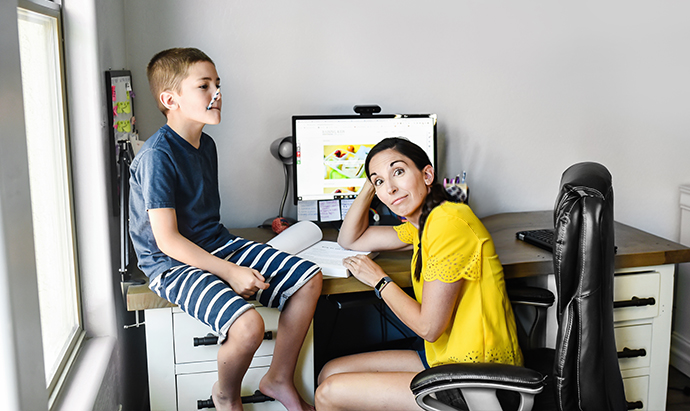
3. Emergency Remote Learning/Crisis Schooling
What most families did when schools were shut down is transition to emergency remote learning, or I’ve seen it called crisis schooling.
This kind of schooling is when kids abruptly go from learning in a school environment to learning virtually or through packets that teachers send home.
According to this article on Educause Review, the authors caution, “These hurried moves online by so many institutions at once could seal the perception of online learning as a weak option, when in truth nobody making the transition to online teaching under these circumstances will truly be designing to take full advantage of the affordances and possibilities of the online format.”
While we were in crisis schooling, I created an Ultimate Home Education Resources Guide that I update often. It has helped us so much as we continue to find activities and projects for my kids to fully engage in learning all subjects.

4. Distance & Online Schooling
Lastly, there is distance learning and online schooling. They are similar in the sense that students engage in schoolwork using a computer.
The difference is that distance learning is when students are given online assignments, lessons, and assessments to do at home whereas online schooling (also known as eLearning) is when students are taught live by a teacher using platforms such as Zoom.
There are also full-time online schools where they do a little of both, live instruction with online assignments.
For the sake of this post, I will be referring to any schooling done at home while parents are working full time or part-time as “homeschooling.” If you’re a homeschool momma, please note I’m not taking away from all the hard work you put into educating your kids. It would just be confusing if I listed all the different types throughout the post. Thank you for understanding!
7 Practical Tips for Homeschooling and Working Full Time
Whether you work from home full time, are remote working from home for the time being, or are a stay-at-home parent with a side hustle, you have probably quickly found that it’s hard to get a whole lot done with kids.
Unless they are taught otherwise, kids can be incredibly needy or desiring your attention all day long.
It can be enticing to let them sit in front of a TV or tablet all day but the research is clear that this is incredibly unhealthy for your child’s brain and autonomic nervous system and it’s hard for your child to thrive in these conditions. *I’m not saying all screen time is awful, it’s just not optimal for growing brains.
Read Next: Why You Should Stop Buying Tech Toys For Your Kids According to Experts
I also want to add that if this way of life is brand new to you and your kids, it can feel extra challenging. Kids who are typically in school are used to having every second of their day scheduled. Sudden ambiguity can cause some unwanted behaviors or resistance.
Kids need routines so life is predictable. Otherwise, they can inadvertently experience increased amounts of stress because the brain perceives the environment as being unsafe.
1. Reframe Your Thinking
The first step to reducing stress while homeschooling while working full time is to reframe your thinking.
Life may have always been a certain way but now it’s different. We can’t continue to think things should happen a certain way just because that’s always how it has always been. Embrace the change and the mess that comes along with change.
As parents, we often unintentionally feel like it’s our responsibility to drop everything to appease or fill our kids’ every request and (what they may think, but it actually isn’t) need.
In our current culture, there’s this underlying message that kids need to be watched at all times, must never get hurt, and never experience any emotion besides happiness. I get it, but not only is it unrealistic, it’s also holding our kids back from growing in so many ways!
Because when we look at developmental research, this is all wrong!
Kids need to explore, make mistakes, fail, and learn how to experience and manage ALL feelings. Also, if you have children who are fighting all the time, instead of solving the problem for them, give them the skills they need. I walk you through how to do teach sibling conflict management skills in this post on sibling conflict.
Bottom Line: Start with a reframe and throw away unrealistic expectations.
Read Next: Five Steps to Raise a Child With Emotional Intelligence
2. Take Care of Yourself First!
I talk about this a lot. If we don’t take care of ourselves and engage in some basic self-care or soul-care, it’s really hard for anyone to thrive.
It doesn’t have to be a long-drawn-out process. I get a lot of my self-care during my morning routine that can either last five minutes or two hours depending on how early my kids wake up.
In the “Taking Care of MYSELF” eBook (which you can grab for free when you sign up for the Raising Kids With Purpose Newsletter), I go through six areas of your life to focus on to avoid running on empty. An absolute must for me is prayer and exercise!
Bottom Line: Parents need self-care.

3. Teach Self-Sufficiency Skills
The science of motivation teaches us that all humans (so kids included!) are born with a need to be autonomous, have a sense of relatedness to others, and want to have a feeling of competency.
This tells us that kids already have the ability to be self-sufficient, some just need more nudging than others. Or they need to experience some freedom in order to prove to themselves they are capable of doing tasks on their own.
This mantra runs through my mind often, “Don’t do for a child what he can do for himself.”
When my three-year-old hands me a tissue to throw away, I stop and think, “Can he do that himself?” If the answer is, yes, then guess who is throwing that tissue away? It’s not me! Because if I do it, how is that useful or helpful to his development?
Now, I’m not a drill sergeant nor am I super crazy about this as I will do things for my children that they can do for themselves. I just try to make sure it’s only when they need some extra love or if I want to model kindness.
It’s hard to know where to start when teaching your child a new skill. In this post, you’ll find four easy steps. I learned this process from Julie Lythcott-Haims’ book, How To Raise An Adult.
Depending on the skill, it can go through all four steps in a few minutes or each step can take a few days or even weeks. Regardless, the goal is to get kids to complete tasks and do life skills on their own without your help!
Bottom Line: Kids are capable of doing a lot on their own.
Check out this new course, “Work From Home With Kids And Thrive.” over on Sparkitivity and receive 25% off with the promo code THRIVE25.
4. Give Your Kids Daily Jobs
Just like in school when kids are given a special job to do to help the teacher, you can also do this at home.
Call these special tasks or ask your child what fun name they want to use. Their teacher may have had a snazzy name you can continue to use at home.
I like to use “special job”! Kids want to feel older than they are and older people have jobs. I’ve also heard these types of tasks called contributions signifying how they are contributing to the family. Whatever floats your fancy!
You can also get more creative or let them pick.
Bottom Line: Encourage your kids to help out around the house.
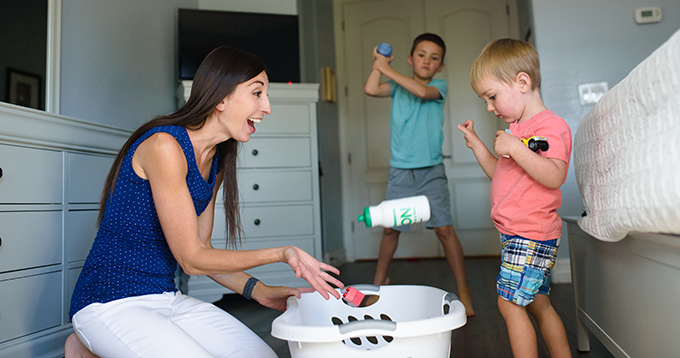
5. Implement Routines and Schedules
Kids need routines.
Period.
Now, they don’t need every second of their day scheduled with a new lesson or activity, but they do need to experience predictability.
In order to be productive while working from home with kids, there has to be some kind of routine. And this routine isn’t just for your little people but for you too.
While homeschooling and working full time, set aside a block of time for “office hours”. This can be a chunk of time when your kids focus on schoolwork if they can work independently or when they have “room time” or “quiet time”.
If you work for an employer, make sure your boss understands that although you have a schedule, it needs to be flexible. Discuss how this will happen and what this will look like.
Bottom Line: Routines and schedules will make life easier.
6. Schedule Quality Time
When your kids’ attention buckets are full, they typically will play on their own or get along with their siblings a lot better.
We tried not scheduling quality time but that didn’t work because we would forget to make time for it. Therefore, we have found that if each kiddo consistently gets even 10 minutes of quality time with me or my husband daily, then they will play by themselves for a lot longer and make better choices (this helps with siblings fighting too)!
Bottom Line: Kids desire one-on-one time if they realize it or not.
7. Get Help When Needed
If you are able to hire a sitter or mother’s helper to play with your kids so you can get a few hours of interrupted work time in, then do it! I did this when I owned my photography business and had two littles under three.
Depending on the age of your children, you could also look for virtual help! My mother-in-law loves to read books to our kids via Facetime since she lives across the country. Find a family member or your kids’ friends who can entertain your kids long enough to get a little work finished. Research supports that this is one way screens are very beneficial for young children!
Bottom Line: Ask for help!
Homeschool While Working
It is doable and can be done if you have the means to be able to work from home.
I have been looking into resources for parents who are required to go to work if schools remain closed and haven’t had a whole lot of luck. If you work outside of the home and have been able to make it work where your kids can still do some kind of online schooling or homeschooling, comment below on how you’re doing it!
Lastly, if you are working from home while homeschooling (or your kids are doing online schooling, distance learning, crisis schooling, unschooling or clown schooling …just checking to see if you are still awake😉), and it isn’t working well, check out this course, “Work From Home With Kids And Thrive.” Enter the PROMO code: THRIVE25 for 25% off!
And as always if these tips helped you, please feel free to share or pin!


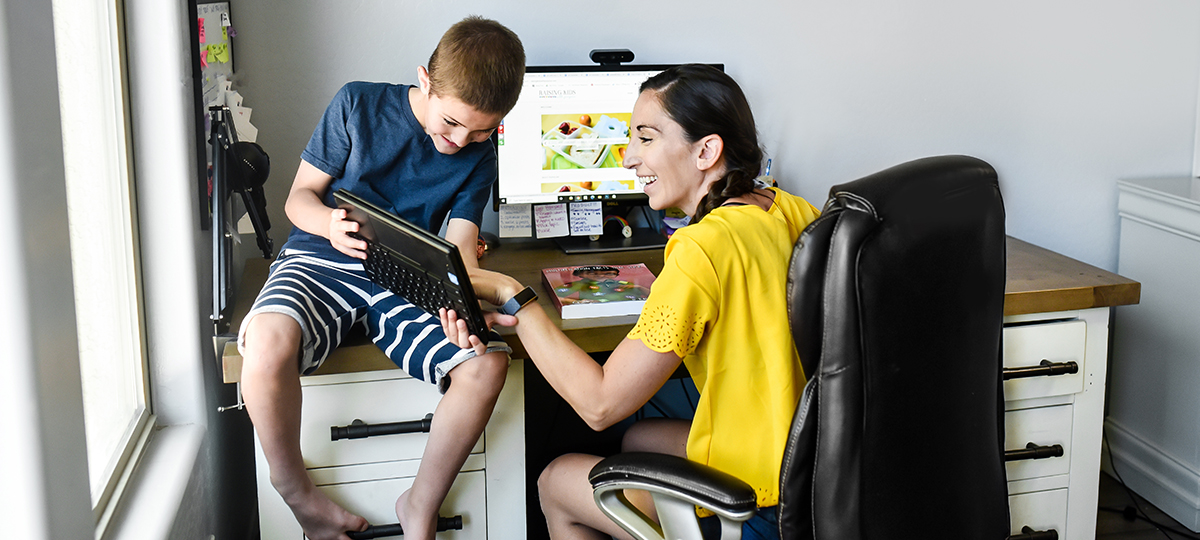
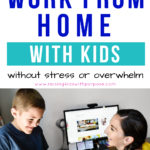
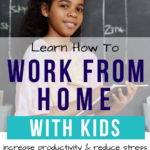

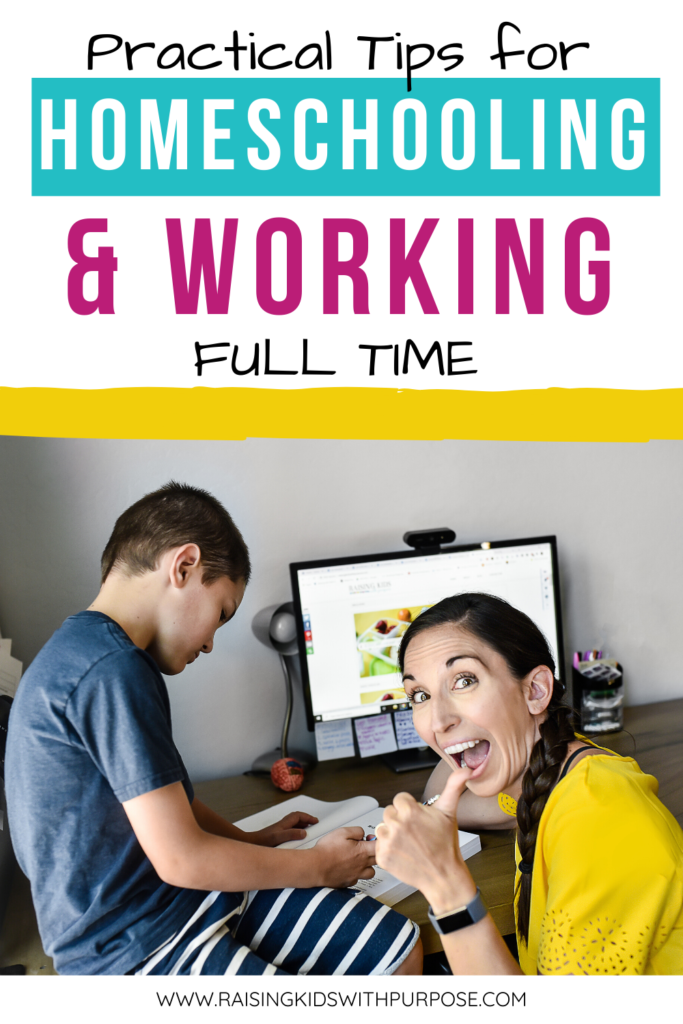
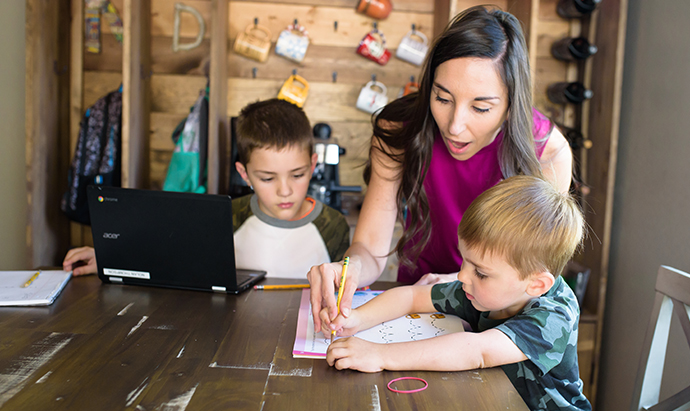







These are great – my absolute favorites are to let go of unrealistic expectations and to assign the special jobs! What a fun way to bring a sense of normalcy and an anchor to the kids’ day. Thanks for sharing what’s been working for you guys!
Thank you! Yes, I never thought of the special jobs untiL I came across it in one of the many articles I read.
Great list! I definitely schedule my time and implement the routine
Thanks! Routines have saved us!
I LOVE the special jobs idea! This is perfect. The more we make it look more like “real school,” the more they will fall into a routine. (I think!)
Yes and then slowly you can adapt to whatever you want homeschool to look like!
It is tough to establish a balance. These are good tips to help us through the coming months for sure!
Yes!
I am a teacher and also have an article in homeschooling, maybe it also helps. I sure learnt a lot from this article! Very helpful for parents!
Thanks!
This is such an important post, as it is starting to look like we might be home with our kids for awhile longer!
I feel like we’re all just holding our breaths waiting to see! Thank you for your kind words!
I like how you included self- care, it really is so important! Great advice!
Self-care is vital! Thank you!
This is a great comprehensive article! I really appreciate the definitions of the different types of homeschooling. There are so many new terms floating around these days it can be hard for parents to keep up!
Thank you soo much! I felt the same exact way which is why I wanted to break them all down. As parents, we have so many options even though they may not be the options we are used to or thought we wanted.
Great tips…thanks for sharing! It is a hard one to balance out but as you say…it is doable! I’ve been working from home for almost 16 years now but I’ve loved having my kids & hubby at home with me. Kids definitely need routine otherwise they are all over the place…and yes…SUPER important for them to have daily “jobs”…it only makes them stronger…;) I absolutely love how you’ve included self-care…definitely something I need to pay more attention to! 😉
I LOVED how you said special jobs make them stronger because that is so true on so many levels! Yes, I think we need to start with self-care so we have more to give!
such wonderful tips considering the current situation
Thank you!
It has been a challenge working and taking care of a toddler. I can’t imagine homeschooling on top of that. Thank you for the tips.
Yes, it’s hard when our kids need our constant attention but it can be done!